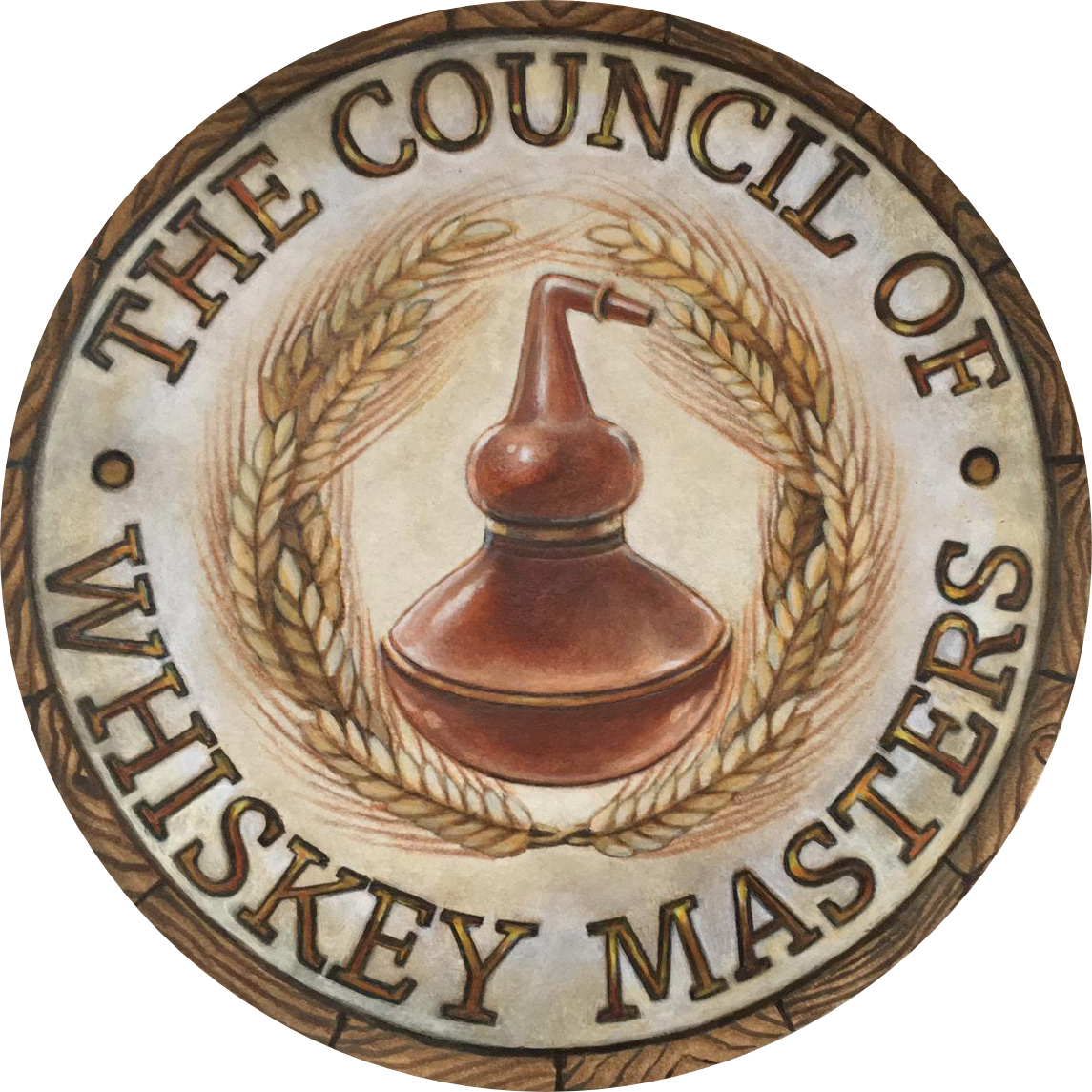Using the Whiskey Tasting Wheel:
Systematic Exploration and Identification of Flavors & Flavor Categories
The Council of Whiskey Masters recommends the official Tasting Wheel published by Whisky Magazine.
An original version of this tasting wheel was developed by the Council’s inaugural board member Charles MacLean.
On this page, we will break down the hard-to-read wheel details, for practical use in daily leisure tastings as well as analytical tastings.
The categories and descriptors shown on this page are part of the official vocabulary for all candidates in the Council’s certifications programs.
The 2 categories on the top left of the Tasting Wheel cover flavor categories that arise from the wood maturation process of the whiskey:
Woody
Winey
The Whisky Magazine Tasting Wheel. credit: whiskymag.com
The first 6 categories starting on the right of the wheel cover flavor categories that arise from the wood maturation process of the whiskey:
Cereal
Fruity
Floral
Peaty
Feinty
Sulphury
Category 1: Cereal Flavors
These flavors are related to malted barley or other grain types.
Cooked Mash
porridge, bran, mash tun draff, cooked, potato skins
Cooked Veg
mashed potato, boiled corn, baked potato
Husky
dried hops, mousey, ale, iron tonic
Malt Extract
malted milk, cattle, cake
Yeasty
boiled pork, sausage, gravy, meaty
Category 2: Fruity Flavors
Appealing aspects from the production process, sweet & fragrant.
Citric
oranges, tangerine, zest, kiwi, nectarines, lemon
Fresh Fruit
apples, pears, peaches, apricot, fruit salad
Cooked Fruit
stewed apple, marmalade, jam, candied fruits, barley sugar
Dried Fruit
raisins, figs, prunes, fruit cake, mince pies
Solvent
nail varnish remover, bubble gum, paint, soda, pine essence
Category 3: Floral Flavors
Scents associated to fresh grass and hay, or leaves.
Fragrant
perfume, fabric softener, barber’s shop, coconut, lavender
Green House
geraniums, green tomatoes, florist’s shop
Leafy
green leaves, lawn clippings, pea pods, fir, pine nuts
Hay
mown hay, dry hay, barns, heather, herbal, sage, mulch
Category 4: Peaty Flavors
In Scotch, peat flavors join the malt during the kilning process.
Medicinal
iodine, carbolic, hospitals, lint, tar, diesel oil, sea-weed
Smokey
bonfire, burnt sticks, incense, peat reek
Kippery
sea shells, dried shellfish, oysters, smoked salmon, anchovies
Mossy
moss water, birchy, earthy, turf, hemp rope, fishing nets
Category 5: Feinty Flavors
Feints enter the picture in the middle the spirits run, and they become milder during wood maturation.
Honey
clover honey, heather honey, mead, beeswax, polish
Leathery
leather upholstery, libraries, new cowhide, biscuits
Sweat & Plastic
buttermilk, cheese, yeast, shoe polish, old gym shoes, plastic rope
Tobacco
dried tea, fresh tobacco, tobacco ash
Category 6: Sulphury Flavors
Mostly developing during distillation, these problematic flavors are moderated through the fluid interaction with copper.
Coal Gas
spent fireworks, burnt matches, matchbox
Rubbery
pencil eraser, new tires, electric cables, burnt rubber
Sandy
fresh laundry, starch, linen, beach, sulphur
Vegetative
brackish, cabbage water, turnips, stagnant, marsh gas
Category 7: Woody Flavors
Partially directly from the oak, partially related to aging, wood maturation increases complexity and balance, and adds color.
Toasted
rice pudding, burnt toast, coffee grounds, fennel, liquorice
Vanilla
custard, crème caramel, sponge, madeira cake, toffee
Old Wood
musty, cardboard, cellars, pencils, cork, ink, metallic
New Wood
resinous, cigar box, sandalwood, cedar, ginger, pepper, nutmeg
Category 8: Winey Flavors
If casks were filled with a type of wine before using them for whisky, some of the wine flavors can become part of the whisky profile.
Sherried
white or red wine, sauternes, fino, oloroso, armagnac, madeira, port
Nutty
walnuts, hazel nuts, praline, almonds, marzipan
Chocolate
cream, butter, milk chocolate, cocoa, bitter chocolate
Oily
linseed oil, candlewax, suntan oil, olive oil
The roundness of a Tasting Wheel indicates that flavor categorization represents a circular continuum:
One type of flavor may blend into the next, often absent of clear borders.
When present in moderation, most of the above tasting descriptors are perceived as positive.
However, presence of some flavors usually fall into the category “nasty”, e.g. metallic, musty, vegetal, cheesy, very meaty, sulphury.
From Description to Evaluation
While the above Tasting Wheel discussion assists during the description of whisk(e)y, other categories and criteria are used during a professional and comparative evaluation of the spirit:
Assessing a whiskey’s Complexity, Balance and Expressiveness may help the taster to arrive at an overall quality assessment.
Further, assessing a sample’s Typicity and Character—its expression of a regional or traditional style alongside the distillery’s unique characteristics—may provide further insight into the product’s identity and relative positioning in the marketplace.
Learn & Apply:
Approach Mastery with The Council of Whiskey Masters
The certification programs at The Council of Whiskey Masters prepare students located around the world for both descriptive as well as evaluative skills in the world of whiskey.
Candidates with a primary interest in Scotch start with the Certified Scotch Professional (CSP) credential, and then advance from there.
Candidates with affinity for Bourbon first take our Certified Bourbon Professional (CBP) exam, then climbing through the levels.
Those candidates interested in the wider segment of Spirits can become Certified Spirits Judges (CSJ), ready for professional judging.

